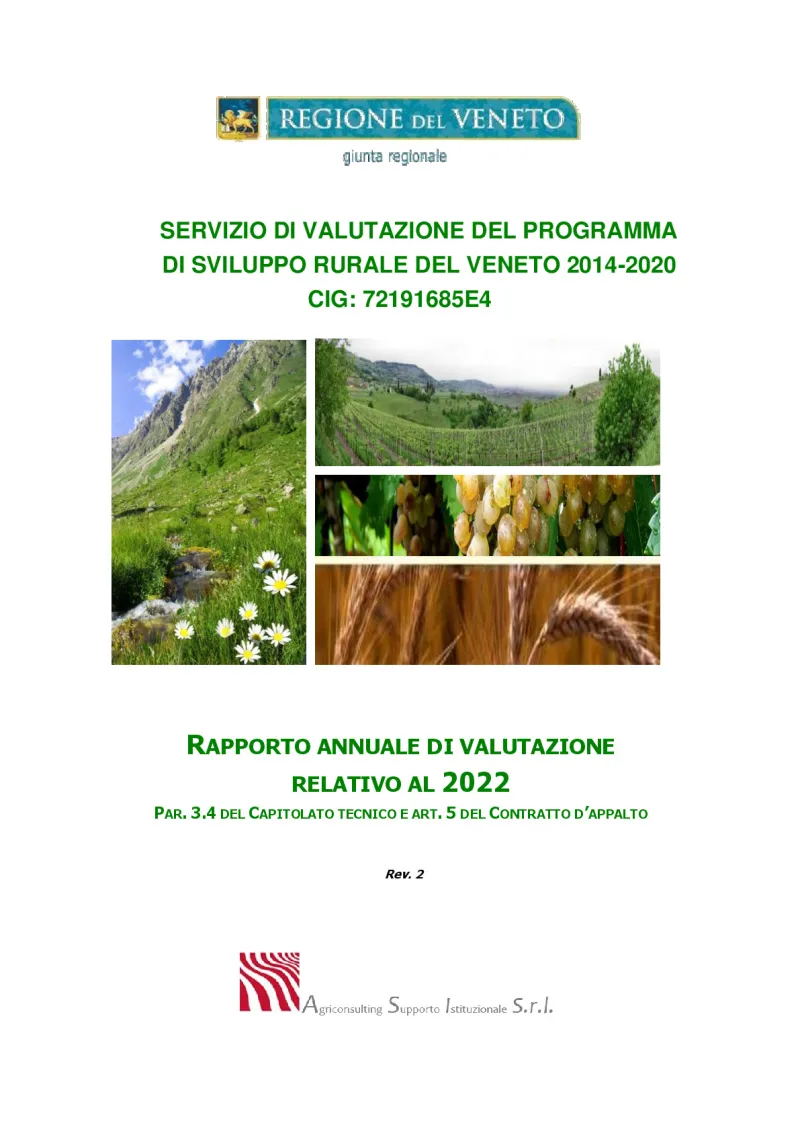Veneto Annual Evaluation Report 2022
The analysis focuses on the effectiveness of the selection criteria adopted in the Rural Development Programme (RDP) calls for proposals of intervention and their usefulness.
- Italy
- 2014-2022
- Cross-cutting impacts

The annual evaluation report is conducted within the framework of the independent evaluation service of the Veneto 2014-2022 RDP and covers the implementation period up to December 2022.
The Report examines the implementation of the RDP, focusing on the quality of the applications funded by assessing the effectiveness of the selection criteria applied to the types of intervention (TI) per individual implementation call. The analysis of the priority criteria concerns the interventions supported under measures (M) M1, M2 (P1), M4.1, M6.4, M8 (FA 2A); M6.1 (FA 2B), M3.2, M4.2 (P3), M8.4 (P4), M8.1 and M8.5 (FA 5E).
The main evaluation elements are the effectiveness of the selection criteria (% of applications that obtained a specific criterion out of the total number of applications financed); the usefulness of the selection criteria (understood as the coherence of the criterion with the objectives assigned by the RDP to that specific RT, the bureaucratic burden resulting from its application, and the weight given to it in terms of scoring); the quality of the applications, understood as the compliance of the submitted projects with the regional strategic priorities.
With regard to the effectiveness of selection criteria adopted in RDP calls for proposals, the analysis shows that the principles and criteria applied in the calls were effective overall (in terms of scoring the applications financed) and also useful in ensuring the selection of applications relevant to the objectives assigned to the various measures.
Particularly positive are the ‘combined’ criteria that assign a score based on the combination of variables (e.g., production sector and type of investment in the case of Measure 4.1). These criteria enable the assignment of different scores to form the ranking list and select applications based on their actual compliance with the priorities defined in the RDP. Although they are more challenging to define and apply, these criteria have a significant impact on the quality of applications. They can direct interventions more effectively towards specific environmental and socio-economic sustainability objectives than other criteria.
With regard to effectiveness of the selection criteria adopted in the LAG calls for proposals, the presence of generic or easily acquired scores, such as the territorial criteria or on the types of investment, which seem to be intended to favour the access of the target group by guaranteeing the overcoming of the in some cases very low barrier threshold, is highlighted as a critical point. Sometimes there is an overabundance of criteria, often made less incisive by limited differences in scoring.
The acquisition of criteria rewarding young people and women was positive, where LAGs managed to achieve comparable, if not slightly better, results than in regional calls.
The least successful criteria are those aimed at selecting new enterprises. Although this criterion is included in all the LAGs and almost all the calls for proposals, it succeeds in funding just one-fifth of the applications with this requirement, a result that is significantly lower than that achieved by the regional calls for proposals. As was also the case at the regional level, the criterion aimed at involving unemployed/unemployable persons, a criterion envisaged by 8 of 9 LAGs and scored higher by 4 LAGs, is also not very effective. Even the criteria that most qualify LEADER action, such as those favouring integration between subjects or between activities, the growth of skills, and innovation, although present and reiterated in numerous calls for proposals, are met to a limited extent.
Author(s)
Agriconsulting Supporto istituzionale S.r.L.